The follicle that is larger in size than the others in both ovaries is considered dominant. This concept is most often used by obstetricians-gynecologists when treating their patients for infertility or when girls are planning pregnancy.
Record content:
- 1 What are ovarian follicles in women?
- 2 Follicle maturation
- 3 Role of dominant follicles
- 4 What does the appearance of a dominant follicle in the left and right ovaries indicate?
- 5 Follicle rate by day of the cycle
- 6 What parameters do follicles have before ovulation?
- 7 How is the day of ovulation calculated by ultrasound?
- 8 When is folliculometry required?
- 9 Possible problems
- 10 Can a "dominant" be empty?
- 11 Follicle video
What are ovarian follicles in women?
Understanding what the purpose is dominant follicle, as well as how it can be tracked, the woman will be able to avoid health problems in terms of the reproductive system.
The dominant follicle is one of the main signs of the onset of the ovulatory phase of the menstrual cycle of a particular woman. By the follicle, gynecologists mean the structural part of the ovary (one of the organs of the female reproductive system). Normally, it should consist of an egg, and also be surrounded not only by the epithelial layer, but also by a double layer of connective tissue.
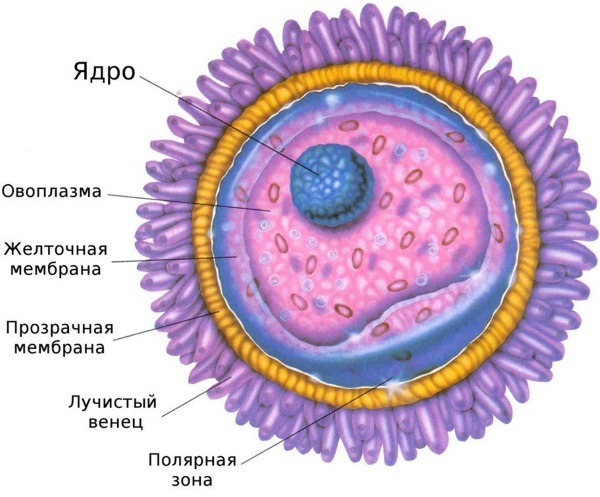
The main components of follicles are:
- Oocyte. This is a form of genetic material, which is an immature egg, or the main cell of the female reproductive system, which plays a key role in the reproduction of its owner. The ovarian follicle should normally contain a single oocyte. It is a kind of cell nucleus that matures during ovulation and participates in the direct process of fertilization - in in the ovulatory phase of the menstrual cycle, the dominant follicle ruptures, and the egg - oocyte, which is inside at this moment, prepares for fertilization. If at this time the sperm penetrates closely into the matured oocyte, during the normal course of the further process, pregnancy will occur.
- Glycoproteins. Proteins, consisting of 2 components, located around the oocyte. They form the second layer of the follicle.
- Granular cells. Protective, third layer of the follicle, enveloping glycoproteins.
- Basement membrane. This is the name of a thin acellular layer designed to delimit connective tissue from the epithelium in the ovarian follicles.
- Theta cells. The outer layer of the follicles.
The main functions of the follicles include:
- support function;
- regulatory;
- trophic.
Analysis of the dynamics of follicle maturation (folliculometry) allows doctors to:
- help the patient in planning pregnancy, predicting the most favorable days (in terms of physiology) for conception;
- diagnose diseases, the signs of which are the absence of ovulation (for example, polycystic disease);
- to evaluate the course of hormone therapy in the treatment of primary infertility.
Follicle maturation
Follicle maturation can be recognized not only by folliculometry, but also by assessing the general condition of a particular woman.

The most common signs of impending ovulation, accompanied by the release of a dominant follicle, are:
- dull pain in the lower abdomen that does not go away even after taking pain reliever;
- tingling in the left or right side of the lower abdomen, in the ovary area (discomfort is usually minor, while both arises and disappears on its own);
- an increase in the amount of mucous discharge from a woman's vagina, as well as changes in their appearance and consistency (discharge becomes more abundant, thicker, and also changes color to a more turbid with a whitish shade);
- decrease in rectal body temperature (specifically on the day of ovulation, that is, rupture of the dominant follicle, basal the temperature is as low as possible, and the next day it begins to rapidly increase to the norm - 37 degrees Celsius);
- an increase in the concentration of the hormone LH in the woman's blood.
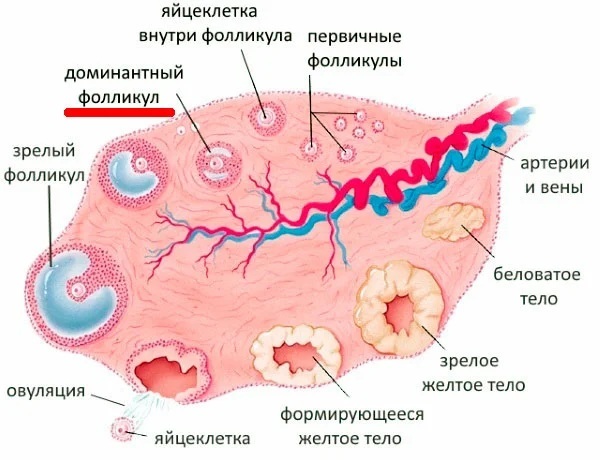
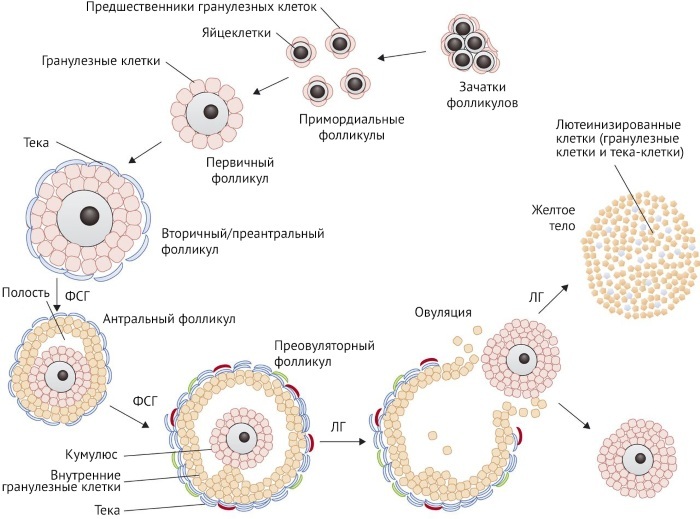
The follicle maturation process can be conditionally divided into 3 main stages:
- A gradual increase in the size of all follicles in the woman's ovaries (the dominant follicle is characterized by an increase of about 2 mm per day).
- Suspension of the growth of all follicles, except for the dominant one. The dominant continues to grow until it reaches about 20 mm in diameter.
- Follicle rupture with the subsequent release of the egg that has matured to this point. At this point, ovulation occurs - a key point in the menstrual cycle.
Role of dominant follicles
The dominant follicle is a structural element of the ovary, which plays one of the main roles in the onset of ovulation within a particular cycle, regulates the female hormonal system, and also determines the further fertilization of the egg that has released into the uterine cavity during rupture follicle.
The maturation of follicles itself, without medication, in particular hormonal therapy, cannot be controlled.
When planning pregnancy, as well as therapy aimed at normalizing the functioning of the reproductive system, it is important for a woman to monitor the absence of factors, which interfere with the normal functioning of the organs of the reproductive system:
- The use of oral contraceptives is OK, for several years without interruption. Most commonly, OCs are available in tablets. Doctors prescribe the intake of the hormonal agents in question for a course, the duration of which usually does not exceed 5-6 months. After the specified amount of time, the body must be allowed to rest - 1-2 months - after which, in the absence of contraindications, resume taking oral contraceptives. Regardless of the period of taking the type of tablets in question, if any discomfort occurs or negative changes in appearance, a woman needs to consult a gynecologist as soon as possible for selection another drug. It is strictly forbidden to stop taking hormonal drugs on your own in the middle or beginning of the menstrual cycle.
- Disorders of the thyroid gland. Such pathologies can occur due to the indiscriminate intake of drugs containing iodine, which can provoke an overabundance or, conversely, a critical understatement of iodized production acid.
- Excessive concentration of prolactin in the blood. The lactogenic hormone, which is necessary for physiological changes during the period of restructuring of the female body after childbirth, inhibits the development of follicles.
- Hormonal disruptions that have occurred for secondary reasons (for example, adolescence, the onset of sexual activity, and so on).
What does the appearance of a dominant follicle in the left and right ovaries indicate?
In some cases, during folliculometry, the doctor cannot determine the dominant follicle, despite the absence of health problems in a particular patient, as well as secondary factors that inhibit the process of approaching her ovulation.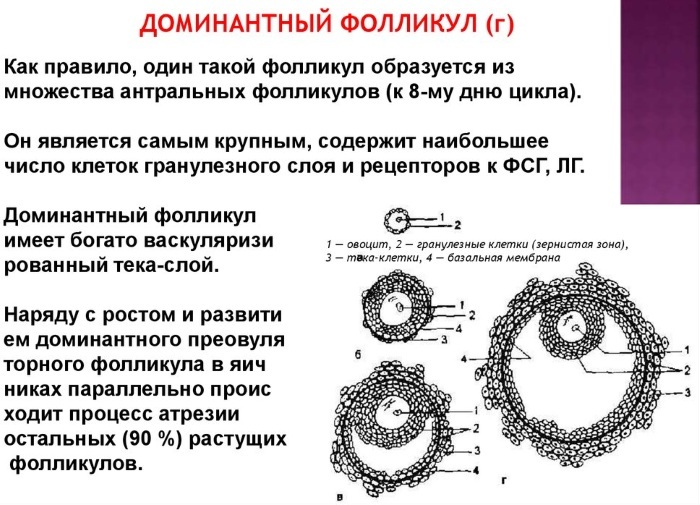
This can be explained as follows:
- a physiological feature, due to which the follicle matures extremely slowly, not having time to reach its maximum size before the end of the menstrual cycle;
- the development of the follicle to the desired size without subsequent rupture (most often this is also a private feature of a particular person);
- "Freezing" of the follicle at one of the initial stages of its maturation (can occur if a day menstrual cycle, when the development of the dominant follicle stopped, women experienced a strong stress);
- up to 1-2 menstrual cycles per year can be anovulatory (during such periods, the woman's reproductive system "sleeps", which means that conception will be impossible);

- the onset of premature menopause (with such hormonal changes, an insufficient amount of hormones is produced, due to which there may be no follicles in the ovaries at all).
The physiology of a healthy woman provides for the maturation of follicles alternately in the right and left ovaries. Despite this, statistics from gynecologists and reproductologists indicate that in 90% of cases, the dominant follicle is found in the right appendage.
This can be explained by the fact that the right side of the human body is more efficient, due to which the blood supply in it is many times greater than on the left. Dominant follicles formed in both ovaries are also not pathological. With this development of events, the chance of a multiple pregnancy increases to 95%.
Follicle rate by day of the cycle
The development of follicles depends not only on the initial health of a particular woman, but also on her age, as well as on the characteristics of the actual state (pregnancy, menopause).
| Feature of a woman's condition | The period of the follicular phase and features of the state of the follicles, which is considered the norm for it |
| A woman aged 20-30 years without serious pathologies | On the 1st day of the menstrual cycle (the beginning of the follicular phase), at least 15-20 small follicles of the same size are found in the ovaries of a healthy woman. Their diameter during this period is not more than 0.5 mm. After 3-4 days, normally a dominant follicle should appear in one of the ovaries (size - about 2 mm). The growth of the dominant follicle is rapidly increasing so that by the middle of the menstrual cycle (the end of the follicular phase and the beginning of the ovulatory phase) its size should reach 20 mm. |
| During pregnancy | Since the main purpose of ovulation in the ovaries is to conceive with the subsequent onset of pregnancy, the ovaries of the expectant mother "sleep" during the period of gestation. This means that multiple small follicles in the appendages are in their original state for all 9 months, and ovulation does not occur. In a small percentage of cases - no more than 3% of the total, ovulation can be observed in the early stages of pregnancy, which is not a pathology. In this case, the development of events follows a similar pattern described in the first paragraph. |
| During menopause | After the onset of menopause, follicles in the ovarian cavity are not identified (96% of cases). In some exceptions, in the presence of follicles in the appendages, they do not develop, remaining in the original number and size, which is the reason for the absence of ovulation, and in some cases of menstruation. |
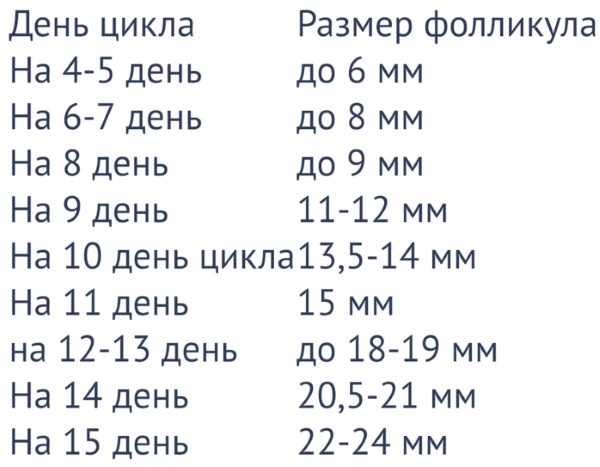
In girls who have not yet reached childbearing age (no menstruation), ovulation, like the dominant follicle, cannot be diagnosed. All follicles in children are in a static state of minimal size. After the onset of menstruation, follicular maturation occurs according to the pattern described above, typical of healthy women at the age of 20-30.
After 40 years, insignificant changes can be observed in the female body due to the upcoming hormonal changes.
What parameters do follicles have before ovulation?
A dominant follicle is a follicle whose size exceeds the diameter of other cells by at least 1.5-2 times. Gynecologists determine the normal course of a woman's menstrual cycle according to generally accepted indicators illustrating changes in the size of the follicles, as well as the rate of their growth.
Under the follicular phase of the menstrual cycle, gynecologists mean the period from the first day of bloody vaginal discharge to the onset of ovulation. With an average cycle time of 28 days, the follicular phase lasts the first 2 weeks.
| The period of the follicular phase of the menstrual cycle | Follicular condition considered normal |
| 1 day from the moment of the onset of spotting | The ovaries contain at least 20 follicles of the minimum size with an immature egg inside each. The diameter of the follicles during this period does not exceed 0.5 mm. Due to the increase in the concentration of hormones, in particular LH and FSH, the follicles begin to increase in size. |
| 4 - 5 days after the onset of spotting | In one of the ovaries, a dominant follicle is found - preantral, the size of which is at least 2 mm. Menstruation ends or the discharge becomes scarce, due to which the endometrium begins to actively increase. |
| One week since the onset of spotting | The dominant follicle in one of the ovaries matures to a size of 5 mm, after which a cavity is formed inside it for subsequent accumulation of follicular fluid and other changes occurring in the body as it approaches ovulation. |
| 13-14 days from the beginning of spotting | The dominant follicle grows up to 20 mm in diameter, due to which its walls are torn, thus releasing the egg that has matured by this time. The ovum is "absorbed" into the opening of the fallopian tube using fimbriae (special tissue processes located in the fallopian tubes). |
How is the day of ovulation calculated by ultrasound?
The dominant follicle is a structural element of the ovary, the size of which can only be determined using ultrasound. If a woman is at the planning stage of pregnancy or is undergoing hormonal therapy, ultrasound should be performed over time, 2-3 times within 5-7 days.
Folliculometry, displaying the real diameter of the dominant follicle, will allow the gynecologist to determine the exact day of the menstrual cycle, as well as calculate the date of the upcoming ovulation.
Folliculometry is performed in accordance with generally accepted standards:
- the first ultrasound scan within the framework of folliculometry should be performed 7-10 days after the first day of menstruation;
- the second and subsequent ultrasounds are recommended every 2-3 days until the day of ovulation is precisely determined;
- in addition to monitoring the development of the dominant follicle within the framework of folliculometry, the gynecologist also describes the state of the corpus luteum;
- if the dominant follicle is not detected within the specified time frame, folliculometry is recommended to continue until the end of the menstrual cycle (before the onset of the next bloody discharge).
All studies carried out to calculate ovulation must be carried out with one ultrasound specialist, on the same ultrasound machine. This minimizes the risk of the doctor making a mistake (due to an error in the device), and also increases the likelihood of making accurate calculations.
When is folliculometry required?
Folliculometry is prescribed by a gynecologist or reproductive specialist for a woman with the presence of one or more indications from the list below:
- Hormone therapy. Follicle maturation will help to suggest the need for a particular woman to take an additional dose of hormonal drugs or, if necessary, on the contrary, to reduce it.
- Determination of the cause of primary infertility. In this case, folliculometry is advisable in conjunction with hormonal studies, as well as regular examinations by a gynecologist.
- Determining the cause of an irregular menstrual cycle. The presence of monthly ovulation indicates the normal functioning of the organs of the woman's reproductive system.
- Mandatory examination before prescribing an in vitro fertilization (IVF) procedure.
- Evaluation of the effectiveness of the stimulation, aimed at the maturation of the dominant follicle and the initiation of subsequent ovulation.

It is not advisable to prescribe folliculometry on your own, since in some cases a qualified gynecologist can diagnose the patient and prescribe concomitant treatment for more significant symptoms and laboratory results research.
Possible problems
The dominant follicle is one of the signs of the normal functioning of the organs of the female reproductive system. Its untimely maturation may indicate serious pathologies that require urgent medical intervention.
The most common female health problems that can be assumed from a diagnosed lack of ovulation are:
- atypical duration of the menstrual cycle (when its duration is less than 21 days or more than 31 days);
- various functional disorders in the work of the ovaries (most often occur due to problems with the production of hormones by the hypothalamus and pituitary gland);
- secondary hormonal disorders arising from diseases of the thyroid or pancreas;
- congenital pathologies;
- polycystic ovary disease (with this disease, the ovaries increase in size, their walls become maximally dense, through which the follicles cannot pass, and the dominant follicle is absent in both the right and left ovary);

- pathology of the cervical canal (diagnosed in the presence of qualitative changes in uterine mucus);
- erosion of the uterine cervix (the need for treatment should be determined by a number of additional examinations, for example, colposcopy);
- pathology of the fallopian tubes (obstruction, violation of the integrity or their local damage);
- unruptured follicle syndrome (considered one of the congenital pathologies);
- endometriosis;
- pathology of the physiological structure of the uterus;
- psychosomatics.
Can a "dominant" be empty?
A dominant follicle is considered empty if there is no follicular fluid and no oocytes in it. Despite the fact that the frequency of diagnosis of empty follicle syndrome varies from 0.3% to 8%, it is difficult to determine the causes of the condition in question in 90% of cases.
The most common reasons for the development of the condition under consideration are:
- untimely stimulation of ovulation;
- ovarian dysfunction (eg, multifollicular ovaries, polycystic, ovarian wasting);
- genetic mutations or a woman's congenital predisposition to infertility;
- the body's response to a specific medication (for example, intolerance to a particular hormonal drug);
- the presence of external factors that negatively affect the development of follicles and the functioning of the organs of the reproductive system as a whole;
- jumps in the level of human chorionic gonadotropin (hCG).
It is generally accepted that the follicle, the size of which indicates the beginning of the ovulatory phase of the menstrual cycle, in which the probability of egg fertilization is maximal, is dominant. It is necessary for every woman to understand what it is, as well as what dysfunctions such a pathology can provoke, regardless of whether she is planning a pregnancy in the near future.
Otherwise, ignoring the symptoms of the anovulatory cycle, the girl runs the risk of starting treatment out of time, which in the future can lead to irreversible consequences, for example, infertility.
Follicle video
Follicle growth and development in women:



